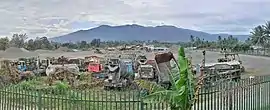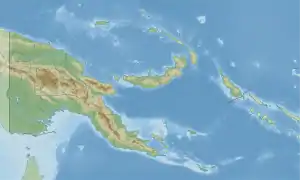Mount Shungol
Mount Shungol (also known as Mount Chungol) is an ultra-prominent summit (ranked number 31) to the west of Lae, in Morobe Province, Papua New Guinea. It is in the Herzog Mountain Range and has an elevation of 2,752 metres (9,029 ft).[2] The Buang people claim ownership to the top of Mount Shungol.[3]
| Mount Shungol | |
|---|---|
 Photograph taken from Lae, facing Mount Shungol from 9 Mile weighbridge | |
| Highest point | |
| Elevation | 2,752 m (9,029 ft) [1] |
| Prominence | 1,518 m (4,980 ft) [1] |
| Listing | Ultra |
| Coordinates | 6°51′48″S 146°42′57″E [1] |
| Geography | |
 Mount Shungol Papua New Guinea | |
| Location | Near Lae, Morobe Province, Papua New Guinea |
| Parent range | Herzog Mountains |
Locale
Dambi Peak 2,250 feet (690 m) is located to the South West, Snake River along the South East base, Aria and Tuoima Creeks to the North West and Wampit River to the West. Omalia and Bupa Missions are West of Mount Shungol while Wago Mission is to the East.[4]
Endemic fauna
Albericus frog
A new species of Albericus from Mt. Shungol has been discovered and inhabits lowland hill forest from the slopes of Mt. Shungol.[5] Albericus is a genus of microhylid frogs endemic to New Guinea. These are small frogs with maximum body length around 27 mm. The genus name Albericus is the Latin form of Alberich, shape-shifting dwarf in the epic poem Nibelungenlied.[6]
Cophixalus frog
The Cophixalus albolineatus whose habitat is the northwestern slope of Mount Shungol. Cophixalus (rainforest frogs or nursery frogs) is a genus of microhylid frogs. These are arboreal species with expanded toe-pads, endemic to Moluccan Islands, New Guinea and northeastern Queensland, Australia.[7]
Citrogramma
Citrogramma is a genus of hoverfly of the insect family Syrphidae whose habitat is on Mount Shungol.[8]
Solanum
Solanum is a large and diverse genus of flowering plants, including two food crops of the highest economic importance, the potato and the tomato. Hartleya Sleum (Stemonur.) is only known from Mount Shungol.[9]
Birds-of-Paradise
Many species of Birds-of-Paradise are endemic to the area. Among one of these is the brown sicklebill. The brown sicklebill (Epimachus meyeri) is a dark blue and green bird-of-paradise with highly iridescent plumages, a sickle-shaped bill, pale blue iris and brown underparts. Mount Shungol and Mount Missim (above the towns of Wau and Bulolo) comprise a centre of endemism for many bird subspecies.[10]
See also
References
- "Papua New Guinea Ultra-Prominence Page". Peaklist.org. Retrieved 2014-04-26.
- Development concept of an appropriate and sustainable agroforestry, Digbib.ubka.uni-karlsruhe.de
- Pacific Islands Monthly. Pacific Publications. 1988.
- SB 55-10 Markham (5.4 MB). "Series T504, U.S. Army Map Service". Home > Finding Information > PCL Map Collection > New Guinea AMS Topographic Maps. University of Texas at Austin. Retrieved 4 March 2014.
- Fred Kraus; Allen Allison & M. J. Lannoo (May 2005). "New Species of Albericus (Anura: Microhylidae) from Eastern New Guinea". Copeia. American Society of Ichthyologists and Herpetologists. 2005 (2): 312–319. doi:10.1643/ch-04-093r1. ISSN 0045-8511.
- Burton, Thomas C.; Zweifel, Richard George (1995). "A new genus of genyophrynine microhylid frogs from New Guinea". American Museum Novitates. 3129: 1–7.CS1 maint: uses authors parameter (link)
- Frost, Darrel R. "Cophixalus albolineatus Kraus, 2012". Amphibian Species of the World: an Online Reference. Version 6.0. American Museum of Natural History. Retrieved 1 March 2014.
- MENGUAL, XIMO (January 2012). "The flower fly genus Citrogramma Vockeroth (Diptera: Syrphidae): illustrated revision with descriptions of new species" (PDF). Zoological Journal of the Linnean Society. 164 (1): 166. doi:10.1111/j.1096-3642.2011.00750. Retrieved 1 March 2014.
- Heads, Michael (2003). "Ericaceae in Malesia: vicariance biogeography, terrane tectonics and ecology" (PDF). Telopea. 10 (1): 311–449. doi:10.7751/telopea20035621. Archived from the original (PDF) on 2011-03-29. Retrieved 2014-03-01.
- Heads, Michael (2002). "Birds of paradise, vicariance biogeography and terrane tectonics in New Guinea" (PDF). Journal of Biogeography. Blackwell Science Ltd. 29 (2). doi:10.1046/j.1365-2699.2002.00667. ISSN 1365-2699. Archived from the original (PDF) on 3 July 2010. Retrieved 1 March 2014.
External links
| Wikimedia Commons has media related to Mount Shungol. |
